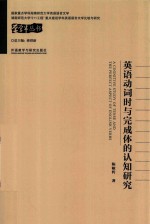

英语动词时与完成体的认知研究PDF电子书下载
- 电子书积分:9 积分如何计算积分?
- 作 者:陈敏哲著;蒋洪新总主编
- 出 版 社:北京:外语教学与研究出版社
- 出版年份:2016
- ISBN:7513581226
- 页数:198 页
Chapter 1 Introduction 1
1.1 Rationale 1
1.2 Research Objectives 7
1.3 Research Values 7
1.4 Research Methodology 9
1.5 Structure of the Book 10
Chapter 2 Literature Review 13
2.1 Introduction 13
2.2 Conceptualization of Time 13
2.3 Previous Studies of Tense in English 15
2.3.1 Tense as a Grammaticalised Means of Time-distinctions 15
2.3.2 Tense as a Deictic Category 26
2.3.3 Tense as a Grounding Element 32
2.4 Previous Studies of the Perfect Aspect in English 38
2.4.1 Uses and Problems of the Perfect Aspect in Modern English 40
2.4.2 Studies of the Perfect Aspect from Three Major Perspectives 43
2.5 Summary 63
Chapter 3 Theoretical Foundations 67
3.1 Introduction 67
3.2 Conceptual Metaphor Theory(CMT) 68
3.2.1 Image-Schema as the Basis of Metaphor 68
3.2.2 Metaphor as a Means of Conceptualization 72
3.3 Conceptual Metonymy Theory(CMYT) 73
3.3.1 Metonymy as a Means of Reference 73
3.3.2 Metonymy as a Means of Conceptualizaiton 74
3.4 Conceptual Blending Theory(CBT) 76
3.4.1 Limits of CMT and CMYT 77
3.4.2 Mechanism of CBT 77
3.4.3 Conceptual Blending as a Means of Conceptualization 81
3.5 Summary 82
Chapter 4 A Study of the Polysemy of the Past Tense from the Perspectives of CMT and CBT 84
4.1 Introduction 84
4.2 Motivations for the Relations among the Various Uses of the Past Tense 86
4.2.1 Levelling of the Inflectional Endings of the Past Tense in Middle English 86
4.2.2 Uniform of the Past Tense in Modern English 88
4.3 Towards a Radial Polysemic Category 90
4.3.1 Infeasibility of the Strategy of Homonymy or Abstraction 90
4.3.2 Meaning Extension of the Past Tense through Metaphor and Conceptual Blending 93
4.4 Summary 107
Chapter 5 A Study of the Polysemy of the Present Tense from the Perspectives of CMYT and CBT 109
5.1 Introduction 109
5.2 Perfective and Imperfective Processes 110
5.3 Motivations for the Relations among the Various Uses of the Present Tense 113
5.3.1 Levelling of the Inflectional Endings of the Present Tense in Middle English 113
5.3.2 Near Uniform of the Present Tense in Modern English 116
5.4 Towards a Radial Polysemic Category 118
5.4.1 The Temporal Meaning of the Present Time 118
5.4.2 The Basic Meaning of the Present Tense 119
5.4.3 Meaning Extension of the Present Tense through Metonymy and Conceptual Blending 127
5.5 Summary 140
Chapter 6 A Study of the Semantic Interactions between Tense and the Perfect Aspect from the Perspective of CBT 141
6.1 Introduction 141
6.2 A New Construal of the Perfect Aspect 142
6.3 Semantic Interactions between the Present Tense and the Perfect Aspect 144
6.3.1 CB among a Perfective Process,the Perfect Aspect and the Present Tense 145
6.3.2 CB among an Imperfective process,the Perfect Aspect and the Present Tense 150
6.3.3 A Radial Polysemic Model of the Present Perfect Aspect 155
6.4 Semantic Interactions between the Past Tense and the Perfect Aspect 156
6.4.1 CB between the Past Tense and the Perfect Aspect 157
6.4.2 A Radial Polysemic Model of the Past Perfect Aspect 159
6.5 Accounts for the Present Perfect Puzzle and Related Problems 160
6.5.1 Accounts for the Present Perfect Puzzle 160
6.5.2 Accounts for the Wh-Puzzle 164
6.5.3 Accounts for the Sequence of Tense Puzzle 167
6.6 Summary 169
Chapter 7 Conclusion 171
7.1 Major Findings of the Present Study 171
7.1.1 Revelation of Radial Polysemic Models of the Past Tense and the Present Tense in English 171
7.1.2 Revelation of Radial Polysemic Models of the Present Perfect Aspect and the Past Perfect Aspect in English 173
7.1.3 Revelation of Consistent and Reasonable Accounts for the Present Perfect Puzzle and Related Problems 174
7.2 Limitations of the Present Study and Suggestions for Future Studies 174
Bibliography 176
Acknowledgements 197
- 《红色旅游的社会效应研究》吴春焕著 2019
- 《汉语词汇知识与习得研究》邢红兵主编 2019
- 《生物质甘油共气化制氢基础研究》赵丽霞 2019
- 《东北民歌文化研究及艺术探析》(中国)杨清波 2019
- 《联吡啶基钌光敏染料的结构与性能的理论研究》李明霞 2019
- 《异质性条件下技术创新最优市场结构研究 以中国高技术产业为例》千慧雄 2019
- 《法语词汇认知联想记忆法》刘莲编著 2020
- 《《国语》和《战国策》词汇比较研究》陈长书著 2017
- 《中国制造业绿色供应链发展研究报告》中国电子信息产业发展研究院 2019
- 《行政保留研究》门中敬著 2019
